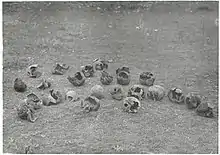Štip massacre
The Štip massacre was the mass murder of Serbian soldiers by the IMRO paramilitaries in the village of Ljuboten, Štip on 15 October 1915, during World War I. Sick and wounded Serbian soldiers, recuperating at the Štip town hospital, were detained by Bulgarian IMRO militants before being taken into the vicinity of Ljuboten and killed. An estimated 118–120 Serbian soldiers were executed in the massacre.
| Štip massacre | |
|---|---|
| Part of World War I | |
 Exhumed remains of those killed in the massacre. | |
| Location | Štip Municipality, Kingdom of Serbia |
| Date | 26 October 1915 |
| Target | Serbian soldiers |
Attack type | Summary executions |
| Deaths | 118–120 |
| Perpetrators | 11th Bulgarian Division Internal Macedonian Revolutionary Organization |
Massacre
On 15 October 1915, two Bulgarian armies attacked, overrunning Serbian units, penetrating into the valley of the South Morava river near Vranje up to 22 October 1915. The Bulgarian forces occupied Kumanovo, Štip, and Skopje, and prevented the withdrawal of the Serbian army to the Greek border and Salonika.[1] Štip was conquered by the 3rd Brigade of the 11th Bulgarian Division commanded Aleksandar Protogerov and the IMRO band of Todor Aleksandrov.[2] Štip and the surrounding area were looted by Bulgarian soldiers who refused to obey orders of requisition.[3] On 26 October, Protogerov ordered the execution of 118–120 wounded and sick Serbian soldiers who at the time were recuperating at the Štip town hospital. Elements of IMRO commanded by Ivan Barlyo and the 11th Bulgarian Division then transported to the outskirts of the Ljuboten village, where they were summarily executed. Similar massacres of Serbian prisoners of war and civilians continued until the end of the war.[4] [2]
Aftermath
The Paris Peace Conference, 1919, separated war crimes into 32 specific classes, forming the basis for the future persecution of war criminals identified in previous national and inter–allied commissions. However the question was subsequently forsaken and the responsibility for the trials fell upon the national courts of the Central Powers. A post war Inter–Allied War Commission investigated allegations leveled against Bulgaria, concluding that Bulgarian occupational authorities in Serbia and Greece had breached every single article of the Hague Conventions of 1899 and 1907. The validity of the Štip massacre was confirmed, its victims were exhumed and the perpetrators were identified. The kingdom of Serbia presented a list of 500 Bulgarians it suspected of war crimes, based on the commission's findings. Bulgaria's official response to the enquiry stated that 3 people were arrested and 2 executed for their involvement in various violations of the rules of war. This was later proved to be false, none of the accused were ever convicted of their crimes.[5]
Gallery
 Remains exhumed in Ljuboten
Remains exhumed in Ljuboten Remains exhumed in Ljuboten
Remains exhumed in Ljuboten Remains exhumed in Ljuboten
Remains exhumed in Ljuboten Remains exhumed in Ljuboten
Remains exhumed in Ljuboten Remains exhumed in Ljuboten
Remains exhumed in Ljuboten
See also
Notes
- Falls 1933, pp. 22–39.
- Pissari 2013, pp. 373–374.
- Reiss 1919, p. 102.
- Report of the International Commission 1919, pp. 57–62.
- Pissari 2013, pp. 363–364.
References
- Albertini, Luigi (1953). Origins of the War of 1914. II. Oxford: Oxford University Press. OCLC 168712.
- Christopoulos, Georgios; Bastias, Ioannis (1977). Ιστορία του Ελληνικού Εθνους: Νεώτερος Ελληνισμός απο το 1881 ως 1913 [History of the Greek Nation: Modern Greece from 1881 until 1913] (in Greek). XIV. Athens: Ekdotiki Athinon.
- Falls, C. (1996) [1933]. Military Operations Macedonia: From the Outbreak of War to the Spring of 1917. History of the Great War Based on Official Documents by Direction of the Historical Section of the Committee of Imperial Defence. I (Imperial War Museum and Battery Press ed.). London: HMSO. ISBN 0-89839-242-X.
- Fischer, Fritz (1967). Germany’s Aims in the First World War. New York: W. W. Norton. ISBN 978-0-393-09798-6.
- Pissari, Milovan (2013). "Bulgarian Crimes against Civilians in Occupied Serbia during the First World War" (PDF). Balcanica. Institute for Balkan Studies (44): 357–390. doi:10.2298/BALC1344357P. Retrieved 8 May 2016.
- Reiss, Rodolphe Archobald (1919). Kingdom of Serbia; Infringements of the Rules & Laws of War Committed by the Austro-Bulgaro-Germans. London: George Allen and Unwen. OCLC 557487215. Retrieved 13 April 2016.
- Report of the International Commission (1919). Album des crimes bulgares : annexes aux documents relatifs aux violations des conventions de la Haye et du droit international en général, commises de 1915-1918 par les bulgares en Serbie occupée. Paris: Yougoslavia. OCLC 17091124.
- Willmott, H. P. (2003). World War I. New York: Dorling Kindersley. ISBN 0-7894-9627-5. OCLC 52541937.